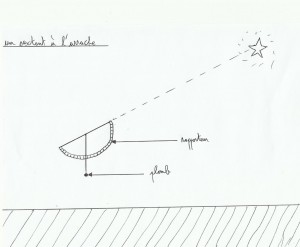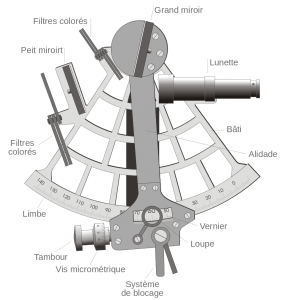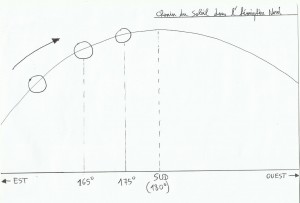This method gives us our position with the sextant, a calculator, a stopwatch and graph paper. However it requires special conditions:
.a clear sky(no joke…)at the time of passage of the sun at local meridian. When the sun will be highest in the sky(half an hour before to half an hour after)in fact.
.The angle between the sun and the horyzon(the true height Hv)should be between 20 ° and 80 °, otherwise we increase imprecision because of the refraction of light(see Snell's law). The more light rays pass through a substantial layer of atmosphere, the more they will be more likely to be diverted, and the more Hv is short, the more the layer's width will increase.
1)Sextant
Contrary to its predecessors(kamal, astrolabe), its set of mirrors that reflects light allows a much more precise calculation of Hv, not disturbed by sea motions. The sextant could be understood as a kind of protractor capable of measuring an angle(Sun / observer / horyzon angle).
Vertical lead line indicates the height of the sun or a star Hv. Obviously at sea with wave motions it is less efficient!
A sextant is as follows:
The large mirror reflects the light on the little mirror. The small mirror is fixed and the largest is moving with the alidade. In the little telescope we must see the bottom of the star in line with horyzon, for that we move the alidade. In fact we move the largest mirror to get them in line. After that we have just to read the height written on the graduated scale("limbe" in French). Height read here is the instrumental height, for the true height there are some things to add on , we will see them further. The less sophisticated sextants have no drum("tambour" in french ), instead of it just a ...("vernier" in French, i'm sorry I don't know its name in English)(for example mack 3), the measurement is read as a caliper in that case. There is a wide range of sextant prices, in plastic, in braw…of course the price rises with precision.
2)Method
First we adjust our watch with accuracy as much as possible on UT hour(Greenwich hour). It is best to have a watch assigned just for UT time. then we will have to find roughly sun passage hour on our navigation area. The simplest method is to take the hand bearing compass and catch the Sun. Why ? because , we know that the sun indicates the South when it is at our local zenith(Northern Hemisphere)and north in the southern hemisphere. When the bearing designated approximates more and more than 180 °(Northern Hemisphere), we begin to make measurements of sun height at regular intervals.
On each measurement of height we write instrumental height and exact time that corresponds to it.
When the sun reaches its zenith(highest height), height does not change and it will stabilize for a while. When it is stable we already adjust the sextant on the last measurement noticed when sun was still rising. Then we look out the sun through the telescope of the sextant , we will see it gradually falling, at the same time we start the stopwatch(write UT time when it's started). When we see the bottom of the Sun “touching” horizon, we stop the stopwatch, we deduce UT found at this moment, and we write it. We will do the same for the before last height seen when the sun was risen, etc.…
The height of the sun at its zenith is easy to notice because the star make a break at this time. This is the height that will allow us to find our latitude, However all the mess seen above will help us to find our longitude.
Calculate the true height Hv
Instrumental height indicated by the "limbe" of our sextant is not exactly true height, we must add corrections to get Hv. There is "collimation" in french( instrumental error, it is provided in the sextant's box), the four angles correction(view angle corrections)found in the astro ephemeris books and calendar correction for the Sun(changes every month, also visible in the ephemeris). The difference between the instrumental height and true height is not huge, but better accuracy, better it is!
Find our latitude
Hv is taken when the sun was highest in the sky, and we calculate Dz. It's easy, Dz=90°-Hv. The latitude is then easy to determine, L=D /-(90°-Hv). This is + if the observation is done with North Pole in the back, and – with the South Pole in the back(D is the declination of the sun at the time of measurement, see “the celestial sphere”).
Determine longitude
The longitude is theoretically easy to guess; with earth's rotations the sun moves from east to west around the globe(earth reference)at a rate of about 15 ° / hour(the earth rotates on itself in 24 hours and has a circumference of 360 °). So knowing the exact time when the sun is at its zenith, and knowing UT time we can easily find it. But when you look at the sun it makes a break when it culminates, so it is difficult to find our longitude precisely. To find it we watch our little graph made at the beginning, on where we have written each height measurement taken with the corresponding time when the sun was risen, and when sun came down. We take an angle measurment(preferably the less close to the zenith time to be more accurate), and the corresponding hours(call them T1 and T2) at the time of the rise and descent for the same measurement height. The sun hour culmination is then equal to T = (T1 T2)/2. Our longitude is then calculated as follows: Longitude =(T-Tpass)*15°/hour(ephemeris give us the sun passage speed which can slightly change depending on the date, see V “the celestial sphere”). Tpass is the time passage of the sun at Greenwich meridian.
Notice: use sextant colored filters to avoid eye injuries. we can remove steadily some filters to have a better view of the sun's edges. The best place to make the measurements is close to the mast, this is where we find some stability if we are shaked by the waves.
Notice: Instrumental error can also be determined by simply watch through the telescope horizon, we make in line in the telescope horizon(the part reflected by the mirror and the part seen through the glass, and we get this instrumental error.


